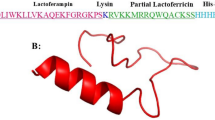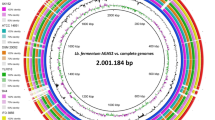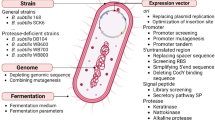Abstract
Bacteriocins are antimicrobial peptides produced by several bacterial species. Among the bacteriocins pediocin-like bacteriocins have a significant inhibitory activity on the foodborne pathogens especially on Listeria monocytogenes. This study aims to select a simple and usable purification method to purify/concentrate the antimicrobial peptide and characterization of the bacteriocin produced by Pediococcus acidilactici 13 by using proteomic approaches which is a recent omic technology. For purification dialysis, ultrafiltration method was used, and as a result of this study the bacteriocin activity reached 819,200 AU/mL from 102,400 AU/mL initially. Two dimensional gel electrophoresis and then matrix-assisted laser desorption ionization/time of flight mass spectrometry (MALDI-TOF MS) analysis were carried out to identify the current bacteriocin and related proteins. Obtained data revealed similarity to pediocin PA-1 transport/processing ATP-binding protein PedD (accession number: P36497), pediocin operon PedC (accession number: Q68GC4) and bacteriocin pediocin PA-1 (accession number: P29430) from UniProtKB/Swiss-Prot databank, thus the bacteriocin produced by P. acidilactici 13 is considered similar to pediocin PA-1.


Similar content being viewed by others
References
Vaucher RA, Gewehr CCV, Correa APF, Sant‘Anna V, Ferreira J, Brandelli A (2011) Evaluation of the immunogenicity and in vivo toxicity of the antimicrobial peptide P34. Int J Pharm 421:94–98
Duffes F, Jenoe P, Boyaval P (2000) Use of two-dimensional electrophoresis to study differential protein expression in divercin V41-resistant and wild-type strains of Listeria monocytogenes. Appl Environ Microbiol 66(10):4318–4324
Anastasiadou S, Papagianni M, Filiousis G, Ambrosiadis I, Koidis P (2008) Growth and metabolism of a meat isolated strain of Pediococcus pentosaceus in submerged fermentation. Purification, characterisation and properties of the produced pediocin SM-1. Enzyme Microb Technol 43:448–454
Altuntas EG, Kocan D, Cosansu S, Ayhan K, Juneja VJ, Materon L (2012) Antibiotic and bacteriocin sensitivity of Listeria monocytogenes strains isolated from different foods. Food Nutr Sci 3(3):363–368
Biswas SR, Ray P, Johnson MC, Ray B (1991) Influence of growth conditions on the production of a bacteriocin, pediocin AcH, by Pediococcus acidilactici H. Appl Environ Microbiol 57:1265–1267
Elegado F, June Kim W, Young Kwon D (1997) Rapid purification, partial characterization, and antimicrobial spectrum of the bacteriocin, Pediocin AcM, from Pediococcus acidilactici M. Int J Food Microbiol 37:1–11
Gurira OZ, Buys EM (2005) Characterization and antimicrobial activity of Pediococcus species isolated from South African farm-style cheese. Food Microbiol 22:159–168
Papagianni M, Anastasiadou S (2009) Pediocins: the bacteriocins of Pediococci. Sources, production, properties and applications. Microb Cell Fact 8:3. doi:10.1186/1475-2859-8-3
Deraz SF, Karlsson EN, Hedström M, Andersson MM, Mattiasson B (2005) Purification and characterisation of acidocin D20079, a bacteriocin produced by Lactobacillus acidophilus DSM 20079. J Biotechnol 117:343–354
Xiraphi N, Georgalaki M, Rantsiou K, Cocolin L, Tsakalidou E, Drosinos EH (2008) Purification and characterization of a bacteriocin produced by Leuconostoc mesenteroides E131. Meat Sci 80:194–203
Gravesen A, Ramnath M, Rechinger KB, Andersen N, Jansch L, Hechard Y, Hastings JW, Knochel S (2002) High-level resistance to class IIa bacteriocins is associated with one general mechanism in Listeria monocytogenes. Microbiology 148:2361–2369
Schneider R, Fernandez RJ, Aguilar MB, Guerrero-Legarreta I, Alpuche-Solis A, Ponce-Alquicira E (2006) Partial characterization of a class IIa pediocin produced by Pediococcus parvulus 133 strain isolated from meat (Mexican chorizo). Food Control 17:909–915
Cosansu S, Kuleasan H, Ayhan K, Materon L (2007) Antimicrobial activity and protein profiles of Pediococcus spp. isolated from Turkish “Sucuk”. J Food Process Preserv 31:190–200
Albano H, Todorov SD, van Reenen CA, Hogg T, Dicks LMT, Teixeira P (2007) Characterization of two bacteriocins produced by Pediococcus acidilactici isolated from “Alheira”, a fermented sausage traditionally produced in Portugal. Int J Food Microbiol 116:239–247
Altuntas EG, Cosansu S, Ayhan K (2010) Some growth parameters and antimicrobial activity of a bacteriocin-producing strain Pediococcus acidilactici 13. Int J Food Microbiol 141:28–31
Tominaga T, Hatakeyama Y (2006) Determination of essential and variable residues in pediocin PA-1 by NNK scanning. Appl Environ Microbiol 72(2):1141–1147
Sofos JN, Geornaras I (2010) Overview of current meat hygiene and safety risks and summary of recent studies on biofilms, and control of Escherichia coli O157:H7 in nonintact, and Listeria monocytogenes in ready-to-eat, meat products. Meat Sci 86:2–14
van Kuijk S, Noll KS, Chikindas ML (2011) The species-specific mode of action of the antimicrobial peptide subtilosin against Listeria monocytogenes Scott A. Lett Appl Microbiol 54:52–58
Carolissen-Mackay V, Arendse G, Hastings JW (1997) Purification of bacteriocins of lactic acid bacteria: problems and pointers. Int J Food Microbiol 34:1–16
Igci N, Demiralp DO (2011) A preliminary investigation into the venom proteome of Macrovipera lebetina obtusa (Dwigubsky, 1832) from Southeastern Anatolia by MALDI-TOF mass spectrometry and comparison of venom protein profiles with Macrovipera lebetina lebetina (Linnaeus, 1758) from Cyprus by 2D-PAGE. Arch Toxicol doi: 10.1007/s00204-011-0763-5
Anderson NL, Matheson AD, Steiner S (2000) Proteomics: applications in basic and applied biology. Curr Opin Biotech 11:408–412
Hamdan M, Righetti PG 2005 Proteomics today. protein assessment and biomarkers using mass spectrometry, 2D electrophoresis, and microarray technology. New Jersey: John Wiley & Sons, Inc
Peker S, Akar N, Demiralp DO (2012) Proteomic identification of erythrocyte membrane protein deficiency in hereditary spherocytosis. Mol Biol Rep 39:3161–3167
Hindre T, Didelot S, Le Pennec JP, Haras D, Dufour A, Vallee-Rehel K (2003) Bacteriocin detection from whole bacteria by matrix-assisted laser desorption ionization-time of flight mass spectrometry. Appl Environ Microbiol 69(2):1051–1058
Schved F, Lalazar A, Henis Y, Juven BJ (1993) Purification, partial characterization and plasmid-linkage of pediocin SJ-1, a bacteriocin produced by Pediococcus acidilactici. J Appl Bacteriol 74:67–77
Laemmli UK (1970) Cleavage of structural proteins during assembly of head of bacteriophage T4. Nature 227:680–685
Bradford MM (1976) Rapid and sensitive method for the quantitation of microgram quantities of protein utilizing the principle of protein-dye binding. Anal Biochem 72:248–254
Pingitore EV, Salvucci E, Sesma F, Nader-Macias ME (2007) Communicating current research and educational topics and trends in applied microbiology. In: Méndezvilas A (ed) Different strategies for purification of antimicrobial peptides from lactic acid bacteria (LAB). Formatex, Spain, pp 557–568
Ivanova I, Kabadjova P, Pantev A, Danova S, Dousset X (2000) Detection, purification and partial characterization of a novel bacteriocin substance produced by Lactococcus lactis subsp. lactis B14 isolated from boza-Bulgarian traditional cereal beverage. Biocatal Fundam Appl 41(6):47–53
Cintas LM, Casaus P, Havarstein LS, Hernandez PE, Nes I (1997) Biochemical and genetic characterization of enterocin P, a novel sec-dependent bacteriocin from Enterococcus faecium P13 with a broad antimicrobial spectrum. Appl Environ Microbiol 63(1):4321–4330
Mantovani HC, Hu H, Worobo RW, Russell JB (2002) Bovicin HC5, a bacteriocin from Streptococcus bovis HC5. Microbiology 148:3347–3352
Maldonado A, Ruiz-Barba JL, Jimenez-Diaz R (2003) Purification and genetic characterization of plantaricin NC8, a novel coculture-inducible two-peptide bacteriocin from Lactobacillus plantarum NC8. Appl Environ Microbiol 69(1):383–389
Ferchichi M, Frere J, Mabrouk K, Manai M (2001) Lactococcin MMFII, a novel class IIa bacteriocin produced by Lactococcus lactis MMFII, isolated from a Tunisian dairy product. FEMS Microbiol Lett 205:49–55
Pinto AL, Fernandes M, Pinto C, Albano H, Castilho F, Teixeira F, Gibbs PA (2009) Characterization of anti-Listeria bacteriocins isolated from shellfish: Potential antimicrobials to control non-fermented seafood. Int J Food Microbiol 129:50–58
Gonzalez CF, Kunka BS (1987) Plasmid-associated bacteriocin production and sucrose fermentation in Pediococcus acidilactici. Appl Environ Microbiol 53:2534–2538
Stein T, Borchert S, Conrad B, Feesche J, Hofemeister B, Hofemeister J, Entian KD (2002) Two different lantibiotic-like peptides originate from the ericin gene cluster of Bacillus subtilis A1/3. J Bacteriol 184(6):1703–1711
Canas B, Fereer DL, Fernandez AR, Camafeita E, Calvo E (2006) Mass spectrometry technologies for proteomics. Brief Funct Genomic Proteomics 4(4):295–320
Acknowledgments
Authors thank to Biotechnology Institution at the University of Ankara for enabling them to carry out proteomic studies in Central Laboratory. This study is based on a part of the Ph.D thesis of Evrim GUNES ALTUNTAS, submitted to Science Institution at the University of Ankara.
Author information
Authors and Affiliations
Corresponding author
Rights and permissions
About this article
Cite this article
Altuntaş, E.G., Ayhan, K., Peker, S. et al. Purification and mass spectrometry based characterization of a pediocin produced by Pediococcus acidilactici 13. Mol Biol Rep 41, 6879–6885 (2014). https://doi.org/10.1007/s11033-014-3573-z
Received:
Accepted:
Published:
Issue Date:
DOI: https://doi.org/10.1007/s11033-014-3573-z




